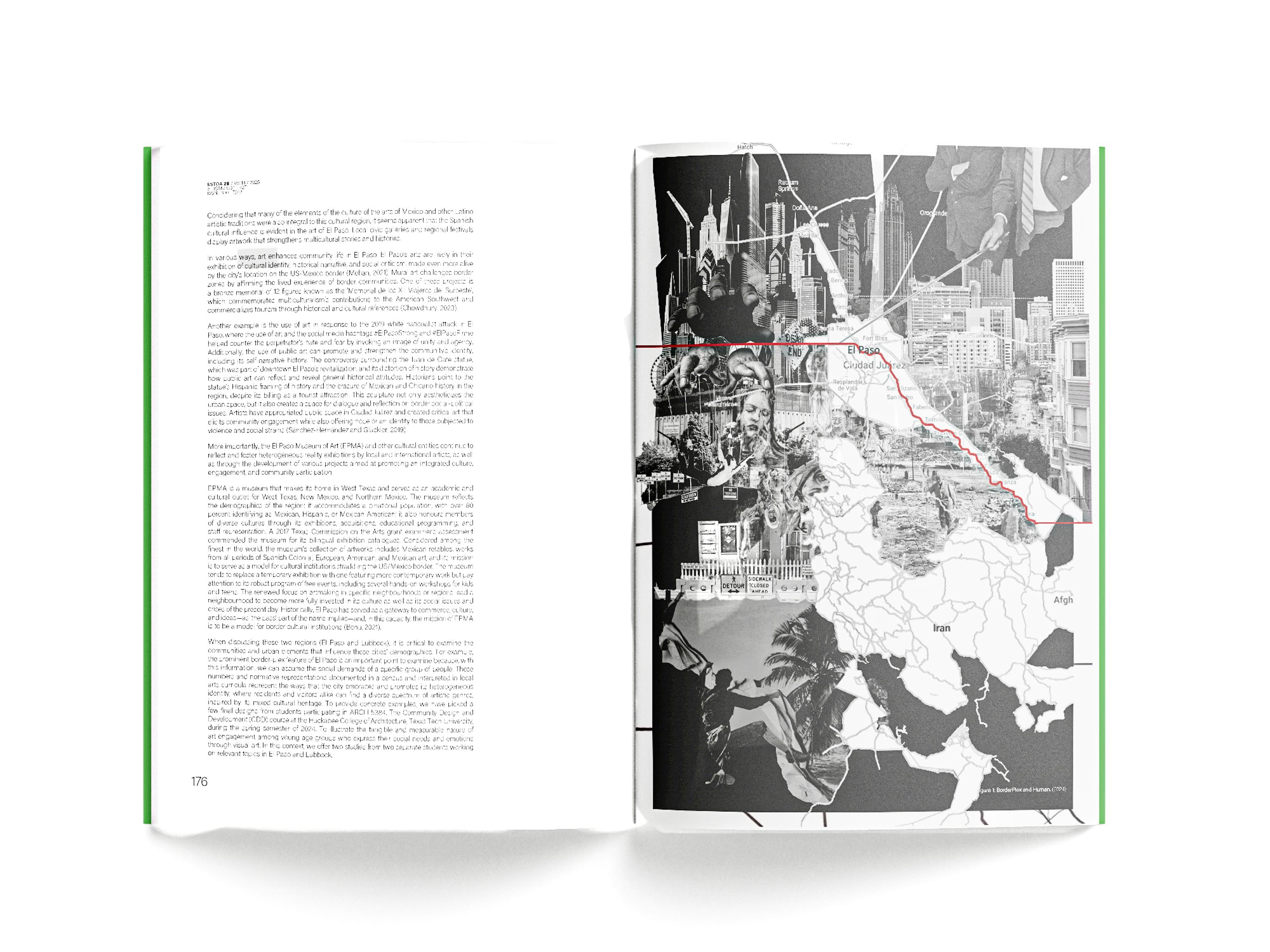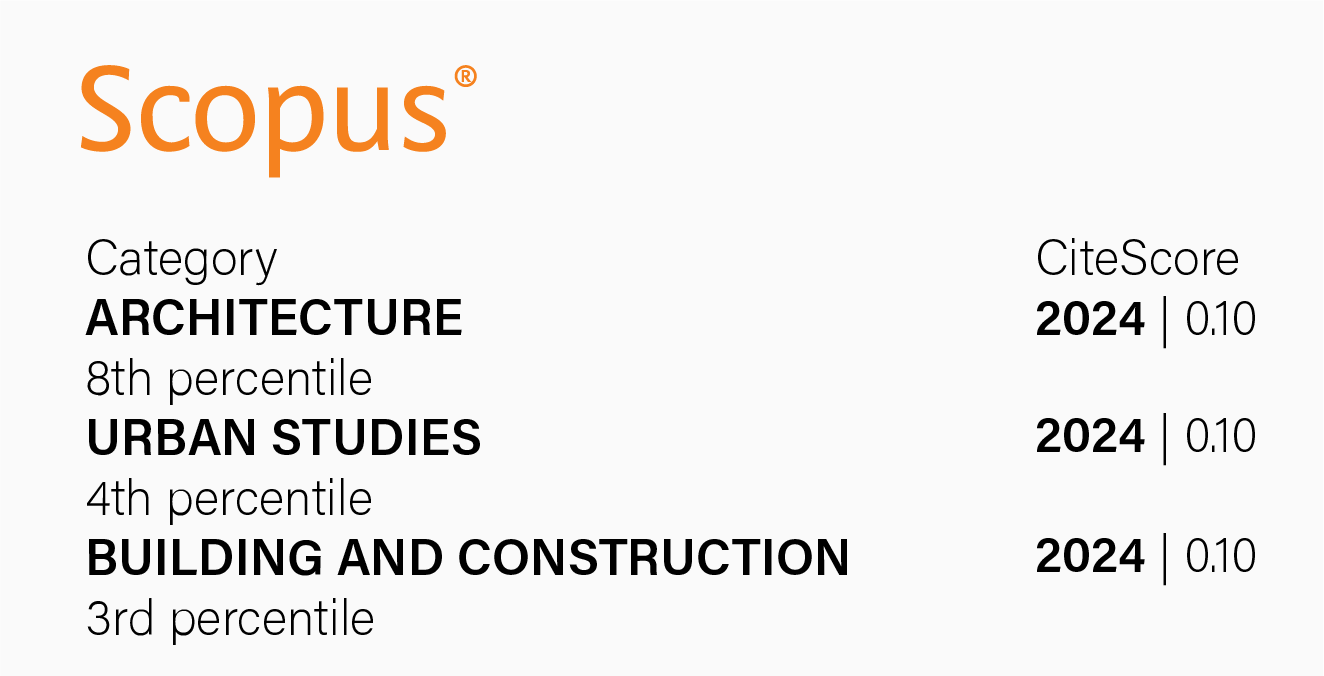Demographic dynamics and art engagement: urban development in Lubbock and El Paso, Texas
DOI:
https://doi.org/10.18537/est.v014.n028.a12Keywords:
urban planning, social needs, art engagement, demographic factors, urban developmentAbstract
Cities serve as dynamic arenas where citizens negotiate needs and co-create solutions to enhance urban life. To address the complexities of contemporary urban living, planning must respond to social justice, economic vitality, and cultural inclusion. This study explores how demographic factors—age, ethnicity, and economics—influence art engagement in two culturally distinct Texan cities: Lubbock and El Paso. Using qualitative comparative analysis and data from a graduate seminar at Texas Tech University, we examine student-led art projects reflecting community experiences. These creative works reveal how art fosters communication, cultural belonging, and social cohesion. Findings underscore that integrating art into urban planning—through public installations, murals, and participatory design—can revitalize underutilized spaces and address diverse community needs. The study argues for art as a tool of creative placemaking, especially in demographically varied cities, emphasizing that culturally responsive engagement strategies can cultivate inclusive, vibrant urban environments.
Downloads
References
Alikhani, S., Mehan, A. (2024). From Ostads to Architects: Evolution of Iranian Architectural Practices in Residential Buildings. In: Cheshmehzangi, A., Roaf, S. (eds.) Persian Vernacular Architecture. Urban Sustainability. Springer. https://doi.org/10.1007/978-981-96-1116-4_2
Aslany, M. (2020). Contested Capital: Rural Middle Classes in India: Rural Middle Classes in India. Cambridge University Press.
Ateca-Amestoy, V., & Prieto-Rodriguez, J. (2023). Whether Live or Online, Participation is Unequal: Exploring Inequality in the Cultural Participation Patterns in the United States. American Behavioral Scientist, 68(11), https://doi.org/10.1177/00027642231177655
Bakshi, A. (2016). The radicals’ city: Urban environment, polarisation, cohesion. Journal of Urban Design, 21(3), 386–387. https://doi.org/10.1080/13574809.2016.1167532
Goldberg-Miller, S. (2022). Engagement in the city: How arts and culture impact development in urban areas. Local Development & Society, 3(1). https://doi.org/10.1080/26883597.2022.2045089
Beauregard, R. A. (2006). The radical break in late twentieth-century urbanization. Area, 38(2), 218–220.
Bone, J. K., Bu, F., Fluharty, M. E., Paul, E., Sonke, J. K., & Fancourt, D. (2021). Who engages in the arts in the United States? A comparison of several types of engagement using data from The General Social Survey. BMC Public Health, 21(1), 1349. https://doi.org/10.1186/s12889-021-11263-0
Bone, J. K., Wan Mak, H., Sonke, J. K., Fluharty, M. E., Lee, J. B., Kolenic, A. J., Radunovich, H., Cohen, R., & Fancourt, D. (2024). Who Engaged in Home-Based Arts Activities During the COVID-19 Pandemic? A Cross-Sectional Analysis of Data From 4,731 Adults in the United States. Health Promotion Practice, 25(2), 244–253. https://doi.org/10.1177/15248399221119806
Bonu, G. (2021). A space of one’s own: Queering the map, challenging the borders: the production of safe spaces in Italian urban areas. Intersectional Perspectives: Identity, Culture, and Society, 0(1), 37. https://doi.org/10.18573/ipics.36
Borst, J. (2010). Urban Strategy: Interactive spatial planning for sustainable cities. Next Generation Infrastructure Systems for Eco-Cities, 1–5. https://ieeexplore.ieee.org/abstract/document/5679227/
Bryant, L., Nandan, M., Cade, S., & Anderson, B. (2023). Recovery Journey of Diverse Populations Using Design Thinking Method: Recommendations for Practitioners and Policymakers. Journal of Social, Behavioral, and Health Sciences, 17(1), 50–66. https://doi.org/10.5590/JSBHS.2023.17.1.05
Check, E., & Walton, S. (2014). Documenting Our Neighborhood: Paintings/Stories from the Eastside. Journal of Higher Education Outreach and Engagement, 18(3), 167–170. https://doi.org/10.20429/jheoe.2014.180311
Cho, H. (2021). The politics of recognition and planning practices in diverse neighbourhoods: Korean Chinese in Garibong-dong, Seoul. Urban Studies, 58(14), 2863–2879. https://doi.org/10.1177/0042098020970450
Churchill, N. (2007). Commentary 1: The Golden Age of the Arts? Cultural Trends, 16(4), 357–359. https://doi.org/10.1080/09548960701692712
Chowdhury, K. (2023). Visualizing Borders: M.I.A.’s “Borders” and Mural Art in Ciudad Juárez and El Paso. In K. Chowdhury, Border Rules (pp. 179–224). Springer Nature Switzerland. https://doi.org/10.1007/978-3-031-26216-6_6
Dash, S. P., & Thilagam, N. L. (2023). “Creative placemaking”: A conceptual model fostering social cohesion in community spaces within residential environments. Creativity Studies, 16(2), 541–564. . https://doi.org/10.3846/cs.2023.16497
Díaz León, B., Martínez Fernández, I., & Palma Martos, L. A. (2021). Temporal restriction and interest for the elderly on cultural participation. The case of spanish performing arts 2019. Scientific Annals of Economics and Business, 68 (Special Issue), 35-52. https://www.ceeol.com/search/article-detail?id=999899
Donovan, J. (2010). An introduction to socially responsible planning and urban design. Environment Design Guide, 1–10. JSTOR – Stable Link
Dowdle, K. (2020). Lubbock’s Art District: The Heart of Downtown - Lubbock EDA. https://lubbockeda.org/lubbocks-art-district-the-heart-of-downtown/
Fan, Z., Su, T., Sun, M., Noyman, A., Zhang, F., Pentland, A. ‘Sandy’, & Moro, E. (2023). Diversity beyond density: Experienced social mixing of urban streets. PNAS Nexus, 2(4), 077.
Fancourt, D., Garnett, C., & Müllensiefen, D. (2020). The relationship between demographics, behavioral and experiential engagement factors, and the use of artistic creative activities to regulate emotions. Psychology of Aesthetics, Creativity, and the Arts. https://psycnet.apa.org/record/2020-02229-001
Fraaije, A. (2023). Can (sm) art save the city? Lessons from action research on art-based citizen engagement towards responsible innovation in ‘smart city’Amsterdam [PhD-Thesis - Research and graduation internal, Vrije Universiteit Amsterdam]. https://research.vu.nl/en/publications/can-smart-save-the-city-lessons-from-action-research-on-art-based
Fraaije, A., van der Meij, M. G., Vermeeren, A. P., Kupper, F., & Broerse, J. E. (2023). Creating room for citizen perspectives in ‘smart city’Amsterdam through interactive theatre. Research for All, 7(1). https://research.tudelft.nl/en/publications/creating-room-for-citizen-perspectives-in-smart-city-amsterdam-th
Gil-Quintana, J., Malvasi, V., Castillo-Abdul, B., & Romero-Rodríguez, L. M. (2020). Learning leaders: Teachers or youtubers? Participatory culture and STEM competencies in Italian secondary school students. Sustainability, 12(18), 7466. https://doi.org/10.3390/su12187466
Greer, N., Fleuriet, K. J., & Cantu, A. G. (2012). Acrylic Rx: A program evaluation of a professionally taught painting class among older Americans. Arts & Health, 4(3), 262–273. https://doi.org/10.1080/17533015.2012.696072
Hart, J., & Henn, M. (2017). Neoliberalism and the unfolding patterns of young people’s political engagement and political participation in contemporary Britain. Societies, 7(4), 33. https://doi.org/10.3390/soc7040033
Kaddar, M., Kirchberg, V., Barak, N., Seidl, M., Wedler, P., & De Shalit, A. (2022). Artistic City-zenship: How artists perceive and practice political agency in their cities. Journal of Urban Affairs, 44(4–5), 471–489. https://doi.org/10.1080/07352166.2020.1792312
Kearns, P. (2020). Freedom of Artistic Expression in International Law. Art Antiquity & L., 25, 99. Institute of Art and Law – Freedom of Artistic Expression in International Law
Mak, H. W., Coulter, R., & Fancourt, D. (2020). Patterns of social inequality in arts and cultural participation: Findings from a nationally representative sample of adults living in the United Kingdom of Great Britain and Northern Ireland. Public Health Panorama: Journal of the WHO Regional Office for Europe= Panorama Obshchestvennogo Zdravookhraneniia, 6(1), 55. https://iris.who.int/handle/10665/331566
Mak, H. W., Coulter, R., & Fancourt, D. (2021). Associations between neighbourhood deprivation and engagement in arts, culture and heritage: Evidence from two nationally representative samples. BMC Public Health, 21(1), 1685. https://doi.org/10.1186/s12889-021-11740-6
Mak, H. W., & Fancourt, D. (2021). Do socio-demographic factors predict children’s engagement in arts and culture? Comparisons of in-school and out-of-school participation in the Taking Part Survey. PloS One, 16(2), e0246936. https://doi.org/10.1371/journal.pone.0246936
McAvinchey, C. (2013). Coming of age: Arts practice with older people in private and domestic spaces. Research in Drama Education: The Journal of Applied Theatre and Performance, 18(4), 359–373. https://doi.org/10.1080/13569783.2013.836920
Mehan, A. (2024a). The Affective Agency of Public Space: Social Inclusion and Community Cohesion, 22. Walter de Gruyter GmbH & Co KG. https://doi.org/10.1515/9783111035642
Mehan, A. (2024b). Decolonizing Architectural Pedagogy: Radical Cities Over Time and Through Space. In: Cole, D.R., Rafe, M.M., Yang-Heim, G. Y. A. (eds.) Educational Research and the Question(s) of Time. Springer. https://doi.org/10.1007/978-981-97-3418-4_21
Mehan, A., Odour, N., Mostafavi, S. (2023). Socio-Spatial Micro-Networks: Building Community Resilience in Kenya. In: Cheshmehzangi, A., Sedrez, M., Zhao, H., Li, T., Heath, T., & Dawodu, A. (eds.) Resilience vs Pandemics. Urban Sustainability. Springer. https://doi.org/10.1007/978-981-99-7996-7_9
Mehan, A. (2023a). Re-narrating radical cities over time and through space: Imagining urban activism through critical pedagogical practices. Architecture, 3(1), 92–103. https://doi.org/10.7202/1097156ar
Mehan, A. (2023b). Re-theorizing the collective action to address the climate change challenges: Towards resilient and inclusive agenda. Canadian Journal of Regional Science, 46(1), 8-15. https://doi.org/10.3390/architecture3010006
Mehan, A. (2023c). Visualizing Change in Radical Cities and Power of Imagery in Urban Transformation. Img Journal, 4(8), 182–201. https://doi.org/10.6092/issn.2724-2463/16093
Mehan, A. & Stuckemeyer, J. (2023a). Collaborative Pedagogical Practices in the Era of Radical Urban Transitions. Dimensions. Journal of Architectural Knowledge, 3(5), 125-142. https://doi.org/10.14361/dak-2023-0508
Mehan, A., & Stuckemeyer, J. (2023b). “Urbanismo en la era de las transiciones radicales: hacia paisajes urbanos postindustriales” in Transición energética y construcción social del territorio ante el reto del cambio climático y el nuevo marco geopolítico. Aranzadi. 145-174. https://www.marcialpons.es/libros/transicion-energetica-y-construccion-social-del-territorio-ante-el-reto-del-cambio-climatico-y-el-nuevo-marco-geopolitico/9788411639545/?utm
Mehan, A., Lima, C., Ng’eno, F., & Nawratek, K. (2022a). Questioning Hegemony Within White Academia. field, 8(1). https://www.field-journal.org/article/id/90/
Mehan, A., Nawratek, K., & Tahar, F. (2022b). Beyond community inclusivity through spatial interventions. Writingplace, 6,136–147. https://doi.org/10.7480/writingplace.6
Mehan, A. (2021) EUKN webinar Port cities and mega-trends: glocal approaches to sustainable transitions. The Port City Futures (PCF) Blog, Leiden. Delft. Erasmus (LDE) Initiative. Port City Futures
Mehan, A., & Tafrata, B. (2022) Embedding justice in resilient climate change action. In: Brears R (ed). The Palgrave Encyclopedia of urban and regional futures. Palgrave McMillan. https://doi.org/10.1007/978-3-030-51812-7_350-1
Mehan, A., & Mehan, M. (2022) Conceptualizing the urban commons. In: Brears R (ed) The Palgrave encyclopedia of urban and regional futures, Palgrave McMillan. https://doi.org/10.1007/978-3-030-51812-7_349-1
Mostafavi, S., Bagheri, B., Scott, C., Montejano Hernandez, E., Howell, C.& Mehan, A. (2025). Integrated Computational Design to Augmented Production of Timber-Dowel Structures: A multi-criteria system for informed variation and community co-production. In Dagmar Reinhardt, Christiane M. Herr, Anastasia Globa, Jielin Chen, Taro Narahara & Nicolas Rogeau. Architectural Informatics (Proceedings of the 30th CAADRIA Conference, Tokyo, Japan: The Association for Computer-Aided Architectural Design Research in Asia) (CAADRIA), 397–406.
Mostafavi, S., & Mehan, A. (2023). De‐coding visual cliches and verbal biases: Hybrid intelligence and data justice. Diffusions in architecture: Artificial intelligence and image generators, 150-159. Wiley Online Library
Musterd, S. (2022). Segregation, neighbourhood effects and social mix policies. In Handbook on Urban Social Policies (pp. 204–218). Edward Elgar Publishing. https://www.elgaronline.com/edcollchap/book/9781788116152/book-part-9781788116152-22.xml
Nursey-Bray, M. (2020). The ART of Engagement Placemaking for Nature and People in Cities. In D. Hes & C. Hernandez-Santin (Eds.), Placemaking Fundamentals for the Built Environment (pp. 305–326). Springer. https://doi.org/10.1007/978-981-32-9624-4_14
Ordeman, W. (2023). Histories of Radical Interactionality: Rivers, Disease, Borders, and Laundry. Rhetoric Society Quarterly, 53(2), 217–230. https://doi.org/10.1080/02773945.2022.2129756
Papachristou, I. A., & Rosas Casals, M. (2016). Unveiling the complex connectivity of human needs in urban places. Towards a better understanding of the social dimension of sustainability. https://upcommons.upc.edu/handle/2117/82858
Paraschiv, R., & Rauf, K. (2022). Integrated and coherent urban planning based on regional development strategies. IOP Conference Series: Earth and Environmental Science, 1026(1), 012037. https://iopscience.iop.org/article/10.1088/1755-1315/1026/1/012037/meta
Peach, J., & Williams, J. (1994). Demographic Changes in the El Paso-Juárez-Las Cruces. Estudios Fronterizos, 34, 117–137.
Rosdil, D. L. (1991). The Context of Radical Populism in Us Cities: A Comparative Analysis. Journal of Urban Affairs, 13(1), 77–96. https://doi.org/10.1111/j.1467-9906.1991.tb00241.x
Sánchez-Hernández, J. L., & Glückler, J. (2019). Alternative economic practices in Spanish cities: From grassroots movements to urban policies? An institutional perspective. European Planning Studies, 27(12), 2450–2469. https://doi.org/10.1080/09654313.2019.1644295
Stern, M. J. (2011). Age and arts participation: A case against demographic destiny. National Endowment for the Arts Washington, DC. https://core.ac.uk/download/pdf/129586724.pdf
Tahar, F., Mehan, A., & Nawratek, K. (2023). Spatial reflections on Muslims’ segregation in Britain. Religions, 14(3), 349. https://doi.org/10.3390/rel14030349
Tappert, S., Mehan, A., Tuominen, P., &Varga, Z. (2024). Citizen Participation, Digital Agency, and Urban Development. Urban Planning 9. https://doi.org/10.17645/up.7810
Thomson, P., & Jaque, S. V. (2023). Ethnicity, creative identity, creative process, and adversity in college and community samples. Journal of Creativity, 33(1), 100044. https://doi.org/10.1016/j.yjoc.2023.100044
Van Hoof, J., & Marston, H. R. (2021). Age-friendly cities and communities: State of the art and future perspectives. International Journal of Environmental Research and Public Health, 18(4), 1644. https://doi.org/10.3390/ijerph18041644
Vanherwegen, D., & Lievens, J. (2014). The Mechanisms Influencing Active Arts Participation: An Analysis of the Visual Arts, Music, and the Performing Arts. Sociological Inquiry, 84(3), 435–471. https://doi.org/10.1111/soin.12043
Varış Husar, S.; Mehan, A.; Erkan, R.; Gall, T., Allkja, L., Husar, M., & Hendawy, M. (2023). What’s next? Some priorities for young planning scholars to tackle tomorrow’s complex challenges. Eur Plann Stud 31(11):2368–2384. https://doi.org/10.1080/09654313.2023.2218417
Villa, E. Q., Hug, S., Thiry, H., Knight, D. S., Hall, E. F., & Tirres, A. (2019). Broadening participation of Hispanics in computing: The Cahsi Includes Alliance. 2019 CoNECD-The Collaborative Network for Engineering and Computing Diversity. https://peer.asee.org/broadening-participation-of-hispanics-in-computing-the-cahsi-includes-alliance
Wei, Y., & Broome, J. L. (2022). Same Standards, Different Classes: A Comparative Case Study of Two Art Classes Within Communities of Contrasting Socioeconomic Status. Studies in Art Education, 63(1), 55–68. https://doi.org/10.1080/00393541.2021.2007689
Williams, C. (2016). Social Work Research and the City. In C. Williams (Ed.), Social Work and the City (pp. 97–120). Palgrave Macmillan UK. https://doi.org/10.1057/978-1-137-51623-7_4
Yao, L. (2023). Urban Planning Strategies Based on Green and Low-Carbon: A Case Study in Guangzhou City, China. Lecture Notes in Education Psychology and Public Media, 14, 177–183. https://doi.org/10.54254/2753-7048/14/20230968
Yazdi, N., & Jürgens, A.-S. (2024). Negar Yazdi: City Art and Urban Planning. W/k-Zwischen Wissenschaft & Kunst. https://between-science-and-art.com/negar-yazdi-city-art-and-urban-planning/
Zamani, F., & Mehan, A. (2019). The abstract space and the alienation of political public space in the Middle East. Archnet-IJAR: International Journal of Architectural Research 13, 483–497.. https://doi.org/10.1108/ARCH-03-2019-0054

Published
How to Cite
Issue
Section
License
Copyright (c) 2025 Estoa. Journal of the Faculty of Architecture and Urbanism

This work is licensed under a Creative Commons Attribution-NonCommercial-ShareAlike 4.0 International License.
The Journal declines any responsibility for possible conflicts derived from the authorship of the works that are published in it.
The University of Cuenca in Ecuador conserves the patrimonial rights (copyright) of the published works and will favor the reuse of the same ones, these can be: copy, use, diffuse, transmit and expose publicly.
Unless otherwise indicated, all contents of the electronic edition are distributed under a Creative Commons Attribution-NonCommercial-ShareAlike 4.0 International License.



